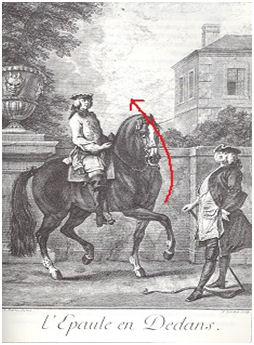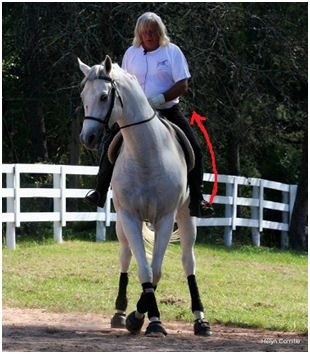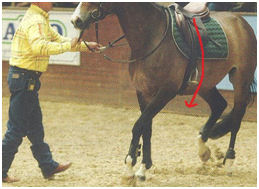Class-Sick
Class-sick
by
Jean Luc Cornille
Even when scientific knowledge was in its infancy, the father of classical equitation advised “an extensive progressive study of science.” (François Robichon de la Gueriniere, Ecole de cavalerie, 1731) Centuries before it was discovered and comprehensively explained, la Gueriniere intuited the concept of transversal rotation associated with lateral bending. “In the cervical and thoracic vertebral column, rotation is always coupled with lateroflexion and vice versa.” (Jean Marie Denoix, DVM, PhD. Spinal Biomechanics and functional anatomy. 1999) The lowering of the inside haunches, that la Gueriniere regards as the main value of the shoulder in demands precisely lateral bending of the thoracic spine associated with proper rotation. Correct rotation shifts the dorsal spines toward the inside of the bend. “In the thoracic spine, as is the case during lateroflexion, the spinous processes bend in the concavity.” (Denoix). On this picture, Chazot executes the right shoulder in combining right lateral bending with the proper rotation, which is a rotation shifting the dorsal spines toward the inside of the bend. This correct rotation is illustrated with a red arrow.
The gravure illustrating Monsieur de la Gueriniere’s shoulder In clearly shows that the classic author sensed and taught the 

concept of proper rotation. La Gueriniere does not talk about proper or inverted rotation because the knowledge of such rotation was not available at his time. Even if la Gueriniere sensed the phenomenon, he could not explain it. It took centuries before the existence of transversal or axial rotation associated with lateral bending was comprehensively explained. La Gueriniere was in fact closer from modern understanding of the equine vertebral column mechanism than many modern trainers who have developed excellent marketing strategies but poor understanding of the equine vertebral column mechanism. 
Inverted rotation, which is illustrated on this picture with the red arrow, places the pelvis in the wrong inclination. The adduction of the inside hind leg is then stressing abnormally the cruciate ligaments of the stifle. Simplicity sells well but also cripples horses as well. Carl Sagan felt the need for a “baloney detection kit,” a way for one to distinguish general falsehood from authentic information. Sagan refers to the baloney detection kit as “BS-Busting.” Moving a horse side way touching his body with a whip does not require any skill and therefore, the technique is popular. However, the comedy does not have any athletic, educative and never the less therapeutic advantage. In order to benefit from any gymnastic exercise, the horse’s body has to be specifically coordinated. At the contrary, when a movement is asked without adequate orchestration of the horse’s physique, the move induces abnormal stresses exposing the horse to physical pain and injuries.
The need for a baloney detection kit is even greater for a horse owner. Marketing strategies develop faster than equine research studies and horse owners need protecting their horse from attractive but destructive baloneys. The solution is understands that correct aids and judging standards, are only very small part of the equation. Gustave Steinbrecht observed that when a horse was coupling lateral bending with proper rotation, the horse’s body formed an angle of approximately 30° with the rail. Steinbrecht also observed that while working at this angle, the horse travelled on three tracks. Steinbrecht was very much detail oriented and he found that adding these observations to the body coordination allowing the horse to benefit from the gymnastic of the shoulder in was helping his students. The angle of 30° and the horse traveling on three tracks were details that Steinbrecht used on the top of a much more detailed explanation, as teaching tools. The inventor of the shoulder in, François robichon de la Gueriniere never advised any 30° angle. La Gueriniere nevr talked about three tracks either. These are details that another trainer added later on as to explain the movement. La Gueriniere suggested moving the shoulders one foot an half to two feet toward the inside of the ring placing the horse’s body into an oblique and circular position. The angle of 30° and the horse travelling on three tracks have become the definition of the shoulder in. This is a comedy; a horse can be placed on an angle of 30° and travelling on three tracks while combining lateral bending and inverted rotation. At the level of the horse’s thoracolumbar spine, the effect will be sharing forces on the vertebral structure and consequently protective reflex contraction of the surrounding muscles. At the level of the inside hind limb, the effect will be kinematics abnormalities stressing the stifle, the hock and the fetlock. Repetitive abnormal stress is the leading cause of limbs injuries.
If the horse seat you toward the outside of the saddle during the shoulder in, or if the weight in on the outside shoulder, or if the horse is heavy on the outside rein, or if the horse has difficulties adducting the inside hind leg, the horse is very likely coupling lateral bending and inverted rotation. You can then, restuff the saddle on one side, change the hoof balance, support the horse with the outside rein or increase the size of the spurs. You are then thinking in line with conventional thinking but you don’t fix anything.
For the shoulder in, the baloney detection kit is definitively the transversal rotation. You need to learn about proper and inverted rotation. You need to learn about the riding and training techniques creating proper rotation. You need to move away from riding and training techniques inducing inverted rotation. Proper and inverted rotation as well as how to create proper rotation, is comprehensively explained in our online course. You need to understand that classical training is not about repeating the words of our predecessors but instead, respect for tradition is understanding and furthering the wisdom of our predecessors in the light of new knowledge. Teaching shoulder in with the wrong rotation is not classic. It is just sick.
Jean Luc Cornille 2014
Online and Mail order IHTC Course


